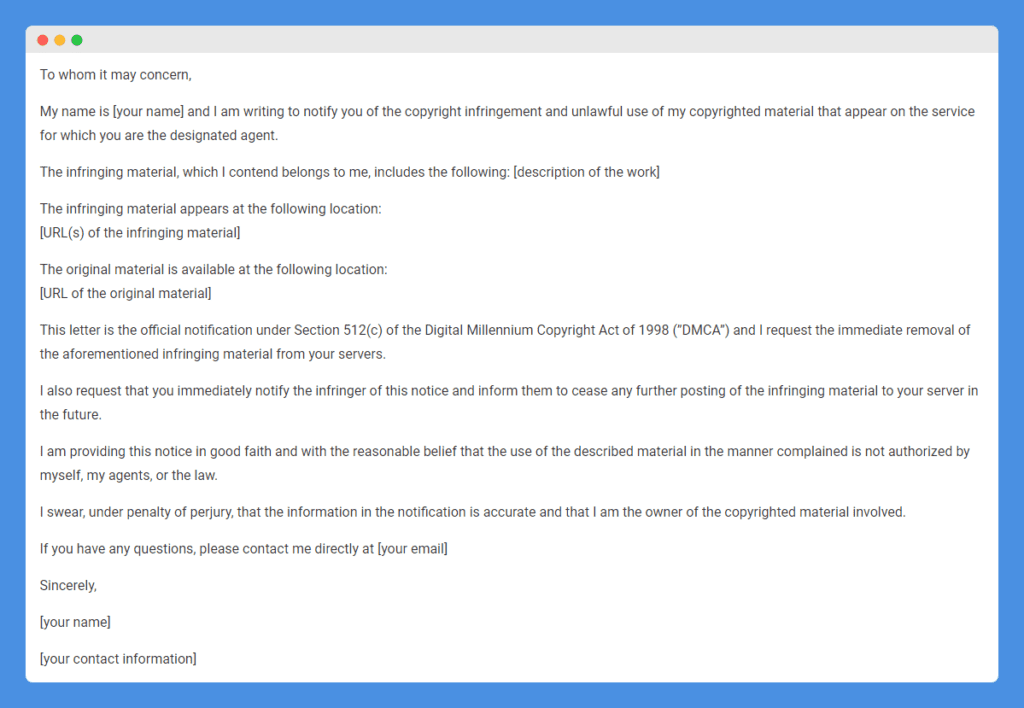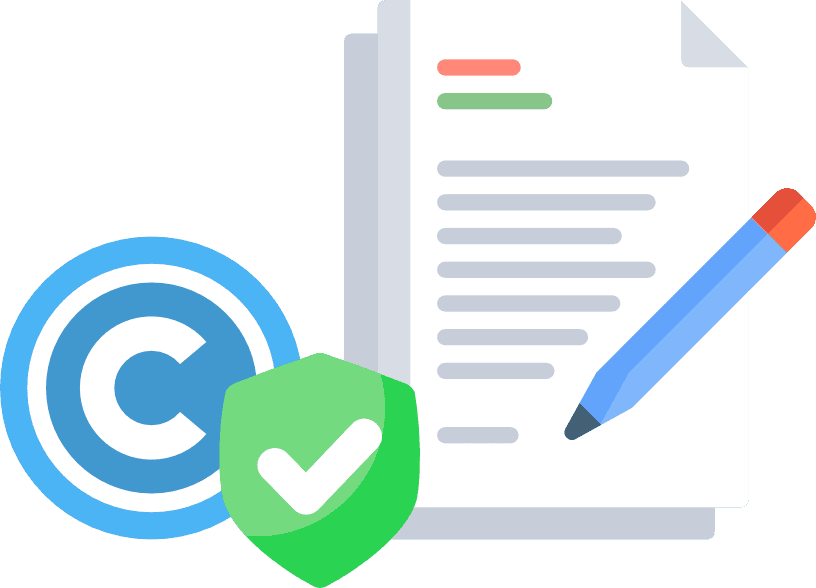An impressive amount of content is shared on the Internet every day. In addition to posting original work, people share and reuse content created by third parties. While this can be taken as a compliment, it can be upsetting for creators to see their photos used without being given proper credit or their work reproduced or modified without permission.
This is where the DMCA comes in. By sending DMCA takedown notices, content creators are able to protect their materials without much hassle, that is if they do it correctly. Before jumping into how to send a DMCA notice the right way, let’s look at what DMCA actually is, how it works, and who it applies to.
Table of Contents
PRO TIP: Don’t waste your time and take the guesswork out of the legal jargon with this personalized DMCA policy generator trusted by over 200,000 businesses.
What Is a DMCA Takedown Notice and How Does It Work?
A DMCA takedown notice can be used by a copyright holder to request that their work be removed from a website or an online platform in the event that it infringes on their copyright.
It is important to note that the work or content does not have to be registered with the U.S. Copyright Office in order for one to be able to submit a DMCA takedown notice.
As long as it is your original content you can successfully request for it to be taken down if it is being used without your permission as you hold the copyright to it from the moment of its creation in a tangible medium.
However, prior to filing such a notice, you should determine if there actually is a copyright infringement and that the usage does not fall under the doctrine of fair use, which allows copyrighted content to be used and reproduced for purposes such as news reporting, research, education, parody, comment, and criticism.
In those cases, permission from the copyright owner is not required and the doctrine could be used as a defense should you file a complaint.
How Does the DMCA Affect Webmasters and Online Service Providers?

The DMCA is interesting in the sense that it protects webmasters and online service providers from being held liable for copyright infringement committed by their users or third parties. Indeed, upon the fulfillment of certain predetermined conditions, the DMCA limits their monetary liability by offering them safe harbor under section 512 of the DMCA.
These safe harbor provisions were enacted to recognize the growth of the online world and encourage service providers to continue operating in this space.
The entities must first qualify as “service providers” according to the following definitions and must engage in one of the following activities to be able to benefit from these safe harbor provisions:
- Transitory Digital Network Communications(internet service providers/telecommunications companies) to qualify as a service provider for this type of activity, an entity must be one that provides data transmission services, routing services, or connections for digital online communications at the request of a user/customer without modifying the content that is being communicated.
A provider of online services or network access, or the operator of facilities therefore of:
- System Caching
- Storage of information on systems or networks at direction of users (web hosting)
- Information location tools (such as search engines and online directories)
Online services providers that fall under and comply with the criteria enacted in section 512 are not liable for monetary damages that could result from copyright infringement by one of their users and are subject to limited injunctive relief only.
They must all, however, satisfy two eligibility conditions under section 512(i) namely :
- Implement a policy under which they terminate the accounts who are “repeat infringers” and inform their users of the existence of that policy
- They must accommodate and refrain from interfering with “standard technical measures”
Moreover, in order to benefit from safe harbor, service providers who are seeking protection under section 512(b) system caching, (c) storage of information, or (d) information location tools must take prompt action.
When they receive a takedown notice under the DMCA (or “actual knowledge” of infringement in the case of (c) web hosting or (d) information location tools), and act promptly to remove the allegedly infringing content and notify the user accused of infringement that their content has been removed. If they fail to do so, they may not be able to benefit from these safe harbor provisions.
You can conclude from the above that service providers must have strong processes and measures in place to promptly address copyright infringement complaints, which is why you will often see on websites a section that is dedicated to copyright and that includes detailed contact information for its designated DMCA agents, who are in charge of receiving and processing those takedown requests.
These limitations of liability make sense considering that a lot of platforms operate by sharing user-generated content or by solely hosting such content without having any real control or oversight over it due to its sheer volume.
It would be unfair for a company to be held liable for a violation committed by one of its users as most of the time these service providers are simply acting as intermediaries.
Does the DMCA Work Outside the USA?
Legally no, as it is American legislation and the content needs to be located or hosted in the United States in order to be subject to the DMCA.
However, in practice, most international service providers will take into account such takedown requests and remove the infringing content even if they are not legally obliged to do so. That is especially true if you, as the copyright holder, are located in the United States and the country in which the infringing website is hosted is a member of the World Intellectual Property Organization (WIPO).
Who Can Send DMCA Takedowns?
DMCA takedown requests can only be sent by two people:
- The copyright owner
- An authorized agent of the copyright owner
As the copyright owner, you do not necessarily have to call on the services of a copyright lawyer to help you prepare and send a takedown notice, as there are some great easy-to-use solutions online that can help you generate a complete DMCA takedown notice in just a few minutes.
You could also choose to use an authorized agent to act on your behalf to maintain some of your privacy. In this case, you will have to confirm that the content is yours and that you authorize the third party that you have selected to act as your representative and submit a takedown notice on your behalf.
How to Send a DMCA Takedown Notice?
If you have found that your content is being used online without your authorization, you may wish to take action and send a DMCA takedown notice.
Note that you could first try to reach out to the website owner directly, especially if it is a smaller website, as they may simply have not realized that they are infringing on your copyright and may promptly take action to rectify the situation.
If that’s not the case, here are the steps that you should follow when preparing your DMCA takedown request.
1. Collect evidence of infringement
You need to let the infringer know what content you are talking about. We recommend taking dated screenshots of the infringing content to keep as evidence. You should also make a copy of the URL links so that you can refer to them in your email and in your takedown notice.
2. Find the infringer’s contact information through their hosting or domain registrar
You can determine through which provider a website is hosted by using free online tools such as hostingchecker.com You simply need to enter the domain to obtain the name of the hosting company. You should then navigate to that service provider’s website.
Once on their website, you should be able to find the service provider’s contact information on a designated DMCA policy page. If not, you can try looking it up on the US Copyright Office DMCA designated agent directory.
3. Draft a DMCA takedown request in the appropriate format
You will then need to draft your DMCA takedown request which should contain the following elements:
- Your name and contact details or that of your authorized agent (mailing address, phone number, and email where you can be reached)
- URLs where the infringing content can be found so that the service provider can locate it
- URLs where your original content can be found
- Brief description or explanation of your original content
- A statement made in good faith confirming that the use of your content is not authorized by yourself, your agent or the law and that you request that the content be removed
- A sentence requesting that the online services provider inform the infringer (website owner) and ask them not to use or publish your content again
- A statement regarding the accuracy and truthfulness of the information that you are submitting in this notice as well as confirming under penalty of perjury that you are authorized to act on behalf of the owner of an exclusive right that is allegedly being infringed
- Physical or electronic signature by yourself, as the copyright owner, or your authorized agent
4. Send the takedown notice
If the online service provider has a specific page on their website explaining how it deals with such requests, follow its instructions. A lot of bigger online service providers have a DMCA takedown form that you can fill out to speed up the process.
Otherwise, you may send a DMCA takedown request to the designated agent of the service provider by email or in writing via regular mail.
5. Keep evidence
You should document and keep a copy of everything: the infringing materials, your original content, and the request that you have submitted, as it could come in handy later on if you need to take further legal action.
You may wish to use a DMCA takedown notice generator to ensure that your request contains all required elements for it to be considered valid and processed without any delay. Our template has been attorney-drafted and is free of errors most people make.
If privacy is a concern, you can call on the services of a third-party agent to deal with the request on your behalf. This is also a great time-saver, especially if you have found your content published without your permission in more than one place on the Internet.
What Happens After Sending a DMCA Takedown Notice?
The online service provider will examine your request as per its processes and, usually in a matter of a few days, will have the content that is claimed to be infringing taken down.
Indeed, service providers have the obligation to respond expeditiously to remove or disable access to the material that is claimed to be infringing copyright after receiving a notice to that effect. This is what is referred to as the “notice-and-takedown process” if they want to be able to benefit from the safe harbor dispositions discussed above.
The service provider will also inform the user who allegedly infringed copyright that it has taken down their content. This will give that party a chance to respond and file a counter-notice should they deem that the takedown notice was unwarranted.
In that case, you, as the copyright owner, would have to consider filing a lawsuit against the allegedly infringing party if you do not want to see your content be put back up by the service provider.
Sample DMCA Takedown Notice Template
Feel free to use this DMCA takedown notice template below. Simply replace content in the brackets with your own information as applicable. It will work just fine for various types of content including articles, photographs, music, and videos, and more.
DMCA Takedowns FAQs
Is the DMCA legit?
It sure is, as it forms an integral part of US intellectual property legislation and it is constantly evolving.
The United States Copyright Office has just produced a 250 pages report on Section 512 for Congress in which it reviews the actual wording of the legislation as well as case law and makes recommendations to improve the effectiveness of the DMCA, most particularly the notice and takedown process.
Any content creator or online service provider should keep a close eye on this piece of legislation that is bound to evolve over the next few years.
What does the DMCA cover?
The DMCA aims to cover and protect copyrighted content that is infringed online.
The Act aimed to strike a balance between protecting individual copyright and promoting the growth of Internet service providers, notably by offering them protection from liability in certain circumstances, such as when they, like the middlemen, inadvertently enable copyright infringement.
By providing a way for copyright owners to submit a takedown notice to a service provider, it gives them a way to enforce their rights without starting judicial proceedings and it fosters cooperation between individuals and the big corporations that host a lot of the content that can be found on the Internet.
What is protected by the DMCA?
Any original work or content that you own and/or that you have created on a tangible medium (and that is thus subject to copyright protection) is protected by the DMCA if it is being used online without your approval.
The definition of content is large: blog posts, text, photos, videos, are all examples of content that could be subject to protection under the DMCA.
Is a DMCA takedown notice the same as a copyright infringement notice?
In practice, the two terms are used interchangeably. However, there is a distinction to be made.
A copyright infringement notice usually takes the form of a cease-and-desist letter and is not limited to content that is infringed online; it also covers literary works such as books, novels or poetry, videos, songs, movies, etc. that could be performed in public or photocopied without permission, for example.
A copyright owner has the exclusive right to reproduce, create derivative works, distribute copies, perform and display their work publicly.
If a third party makes and sells copies of said work without obtaining prior authorization of the copyright owner, it would constitute a violation and, thus, could lead to that third party receiving a copyright infringement notice which could result in a lawsuit.
This copyright infringement notice is sent to the infringing party directly rather than to the online service provider and usually threatens to take legal action should the recipient fail to rectify the situation.
What is the safe harbor provision under the DMCA?
The safe harbor provisions can be found in section 512 of the DMCA, which we mentioned earlier in this article when discussing how the DMCA affects webmasters and online service providers.
In simple terms, the DMCA safe harbor provisions give an incentive to online service providers to promptly take action and remove allegedly infringing content when it learns of its existence by shielding them from liability for monetary relief and not holding them responsible for the illegal actions of their users (of course, some conditions need to be met).
How long does a DMCA takedown notice take?
There is no set time frame, other than the fact that online service providers have to act expeditiously to remove the allegedly infringing material; this can be a few hours to a few days, depending on the circumstances.
How long it will take could depend on a variety of factors, such as the time-sensitive nature of the content that needs to be taken down or the number of materials that need to be removed, for example.
The removal process could also take longer than expected should your DMCA takedown notice be incomplete – in that case, the online service provider might have to request additional information from you in order to process your request. This is why submitting a complete and compliant notice in the first place is primordial.
What countries ignore the DMCA?
There is no official list of countries that ignore the DMCA but some are more notorious than others for protecting freedom of speech over intellectual property.
Countries that come up often when that subject is discussed in online forums are Russia, Singapore, the Netherlands, Bulgaria, Luxembourg, and Malaysia.
At the end of the day, the service provider is the one that decides to process or ignore a DMCA notice – some hosting providers will claim that they provide offshore “DMCA Ignored Hosting”.
If you find that a service provider in a certain country is ignoring your DMCA takedown request, you could alternatively try to submit a request to Google so that it at least does not appear in search results.
You may also want to check with a local intellectual property lawyer as the country where the website is hosted may simply have different laws and processes to deal with such a matter.




